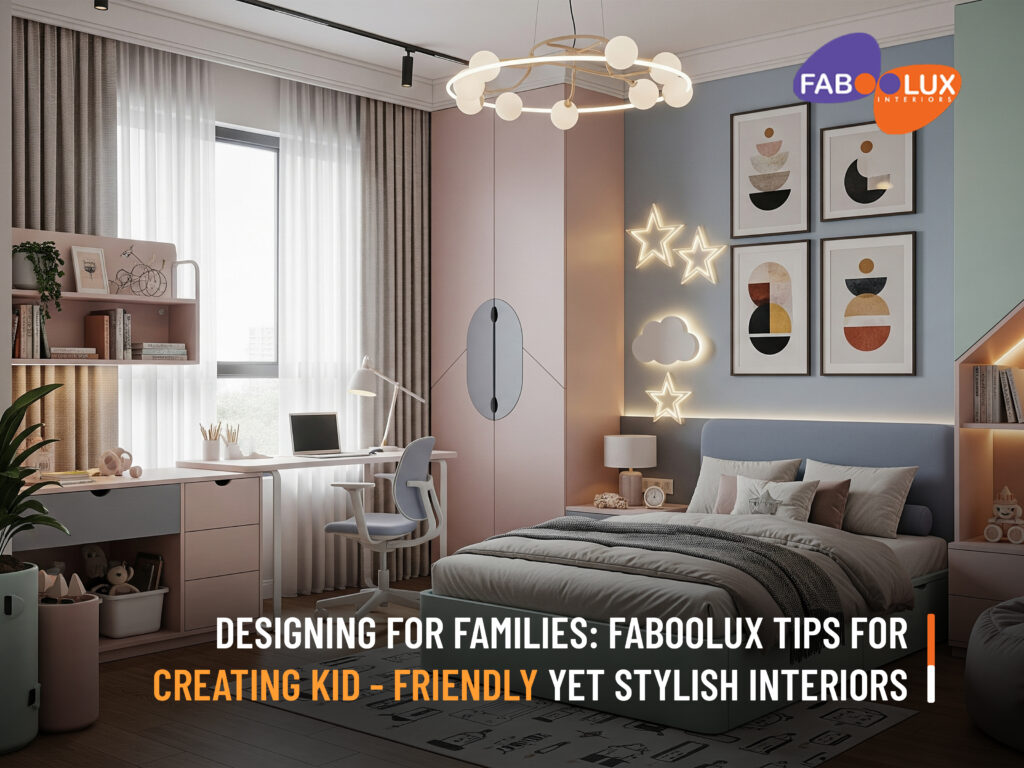Designing a home that’s both inviting for children and elegant for adults can feel like balancing on a tightrope. At Faboolux, we believe that family-focused interiors shouldn’t come at the expense of style. In Kerala’s vibrant culture and lush landscapes, creating spaces that are functional, safe, and beautiful is both an art and a science. Here’s our comprehensive guide to designing family-friendly interiors that grow with your children and reflect your personal taste.
1. Understanding Family Needs
Every family is unique, and so are its design requirements. When planning a family-centric space, consider:
- Safety: Young children require environments free from hazards.
- Durability: High-traffic areas need materials that stand up to wear and tear.
- Flexibility: As children grow, their needs shift. Opt for layouts and furnishings that adapt.
- Style: Your home should feel personal and sophisticated, not like a daycare center.
Tip: Host a family “idea session” where even the little ones can sketch or pick color swatches. Including everyone ensures the result reflects your household’s personality.
2. Safety First: Non-Negotiable Features
Safety isn’t optional—it’s the foundation of any child-friendly home. Incorporate these must-haves from day one:
- Non-Toxic Materials: Choose paints, finishes, and fabrics labeled “low-VOC” or “non-toxic.”
- Rounded Edges: Invest in furniture with curved corners or install edge guards on sharp surfaces.
- Childproofing Elements: Outlet covers, cabinet locks, and anti-tip furniture straps are simple additions that provide peace of mind without sacrificing style.
3. Smart Storage Solutions for Clutter-Free Living
Kids accumulate toys, books, and crafts faster than you can say “cleanup.” Keep clutter at bay with:
- Multi-Functional Furniture: Ottomans, benches, or beds with built-in drawers provide hidden storage.
- Accessible Bins and Shelves: Label woven baskets or colorful bins so children can (and will) help tidy up.
- Rotational System: Store off-season toys in labeled boxes and swap them quarterly. It keeps play areas fresh and manageable.
4. Playful Yet Practical Zones
Designated play spaces allow creativity without disrupting the entire home. Consider:
- Indoor Tents & Reading Nooks: A cozy tent or corner with floor cushions invites imaginative play.
- Art Corners: Mount a small easel or table against a washable wall finish for easy art clean-up.
- Seamless Integration: Use area rugs or low shelving to define play zones that visually blend with your décor.
5. Personalization and Creativity
Foster your child’s imagination by making them co-creators of their space:
- Themed Decor: Subtle themes like “under the sea” or “forest adventure” can be elevated with tasteful accents—think framed prints rather than vinyl stickers.
- Interactive Walls: Install a chalkboard panel or magnetic board for doodles and artwork displays.
- Collaborative Choices: Let kids choose an accent pillow or paint sample; their involvement builds pride in their room.
6. Durable, Washable, and Stylish Materials
Kids are messy—embrace it with smart material selections:
- Performance Fabrics: Stain-resistant upholstery that you can wipe down easily.
- Washable Rugs: Machine-washable mats in play areas protect floors and simplify maintenance.
- Eco-Friendly Options: Bamboo, jute, and reclaimed wood bring warmth and sustainability to your design.
- Color Balance: Mix cheerful hues (maybe a punchy cushion or rug) with neutral walls and furniture for a timeless look.
7. Study and Rest: Functional Spaces for Growth
As children grow, they need dedicated areas for learning and relaxation:
- Ergonomic Study Zones: Adjustable-height desks and chairs support proper posture. Add task lighting to reduce eye strain.
- Calming Sleep Environments: Soft bedding, blackout curtains, and gentle nightlights create a restful atmosphere.
- Flexible Layouts: A modular desk or a daybed with trundle allows the space to transition from study to sleep to play.
8. Lighting and Ambience
Layered lighting transforms functionality and mood:
- Ambient Lighting: Ceiling fixtures or pendants provide overall illumination.
- Task Lighting: Desk lamps and reading sconces focus light where it’s needed.
- Accent Fixtures: String lights or whimsical lamps add personality.
- Natural Light: Position work and play areas near windows. Use sheer curtains to maximize daylight while maintaining privacy.
9. Kerala-Inspired Touches for Local Relevance
Incorporate the rich heritage of Kerala to root your design in its surroundings:
- Traditional Woodwork: Carved teak or rosewood elements in furniture or paneling.
- Handloom Fabrics: Muralis, kasavu-inspired throws, or upholstery evoke local craftsmanship.
- Local Art: Display coastal landscapes, Theyyam prints, or pottery from nearby artisans.
- Modern-Traditional Blend: Pair a contemporary sofa with a classical wooden swing (oonjal) for a statement.
10. Maintenance and Adaptability
A home must evolve alongside its inhabitants:
- Modular Furniture: Shelving units or seating systems that can be reconfigured.
- Easy-to-Clean Surfaces: Quartz countertops, laminate tables, and tiled backsplashes stand up to spills.
- Future-Proofing: Choose neutral core pieces and let accessories (cushions, art, curtains) adapt to changing tastes.
Conclusion
Designing kid-friendly yet stylish interiors is about foresight, creativity, and a touch of playfulness. From safety-first features to Kerala-inspired detailing, Faboolux is your partner in crafting family spaces that look beautiful today and adapt effortlessly tomorrow.
Ready to Transform Your Family Home? Consult with Faboolux’s expert interior design team and discover personalized solutions that cater to every member of your household. Contact us today to schedule a free design consultation and take the first step toward the perfect family-friendly home.

